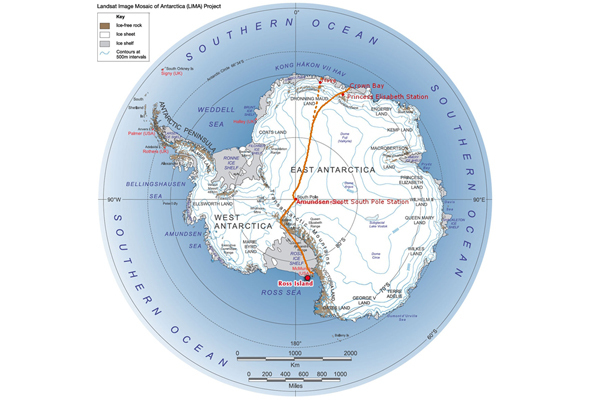
Frostbite Forces Adventurer to Quit Antarctic Trek

Seasoned adventurer Sir Ranulph Fiennes has had to quit his attempt to be the first person to cross the South Pole on skis during the brutal Antarctic winter.
Fiennes, who has abundant experience in harsh environments, will be evacuated from the coldest continent after developing a case of frostbite, according to a blog post on the website of the expedition, called The Coldest Journey. Fiennes and his team made the decision to have him evacuated while it was still possible before the beginning of the formidable winter, with its near-permanent darkness and temperatures as low as minus 130 degrees Fahrenheit (minus 90 degrees Celsius).
"This decision has not been taken lightly and it is, naturally, a huge disappointment to Fiennes and his colleagues," the post said.
Fiennes will be driven by Ski-Doo, a type of snowmobile, some 40 miles (70 kilometers) from his team's current location to Belgium's Princess Elisabeth Station, located near the coast of East Antarctica, according to the blog post. From there, he will make his way by plane to Cape Town, South Africa.
The evacuation plan is currently being hampered by a blizzard at the team's location.
Once Fiennes is evacuated, the rest of the team has elected to carry on with the journey. They are still slated to begin their crossing on the originally planned date of March 21. The full crossing route will take them from Princess Elisabeth through the interior of the continent to the Amundsen-Scott South Pole Station (named for the two explorers that raced to be the first to the South Pole), then over the Transantarctic Mountains onto the Ross Ice Shelf and to the United States' McMurdo Station, situated on the shore of the Ross Sea. In total, the trek will cover more than 2,000 miles (3,200 km) and take six months.
Fiennes has gone on previous Antarctic and Arctic excursions, climbed to the summit of Mount Everest and run seven marathons in seven days on seven continents, according to his expedition biography.
Sign up for the Live Science daily newsletter now
Get the world’s most fascinating discoveries delivered straight to your inbox.
Reach Andrea Thompson at athompson@techmedianetwork.com and follow her on Twitter @AndreaTOAP and on Pinterest. Follow OurAmazingPlanet on Twitter @OAPlanet. We're also on Facebook and Google+.

Andrea Thompson is an associate editor at Scientific American, where she covers sustainability, energy and the environment. Prior to that, she was a senior writer covering climate science at Climate Central and a reporter and editor at Live Science, where she primarily covered Earth science and the environment. She holds a graduate degree in science health and environmental reporting from New York University, as well as a bachelor of science and and masters of science in atmospheric chemistry from the Georgia Institute of Technology.









